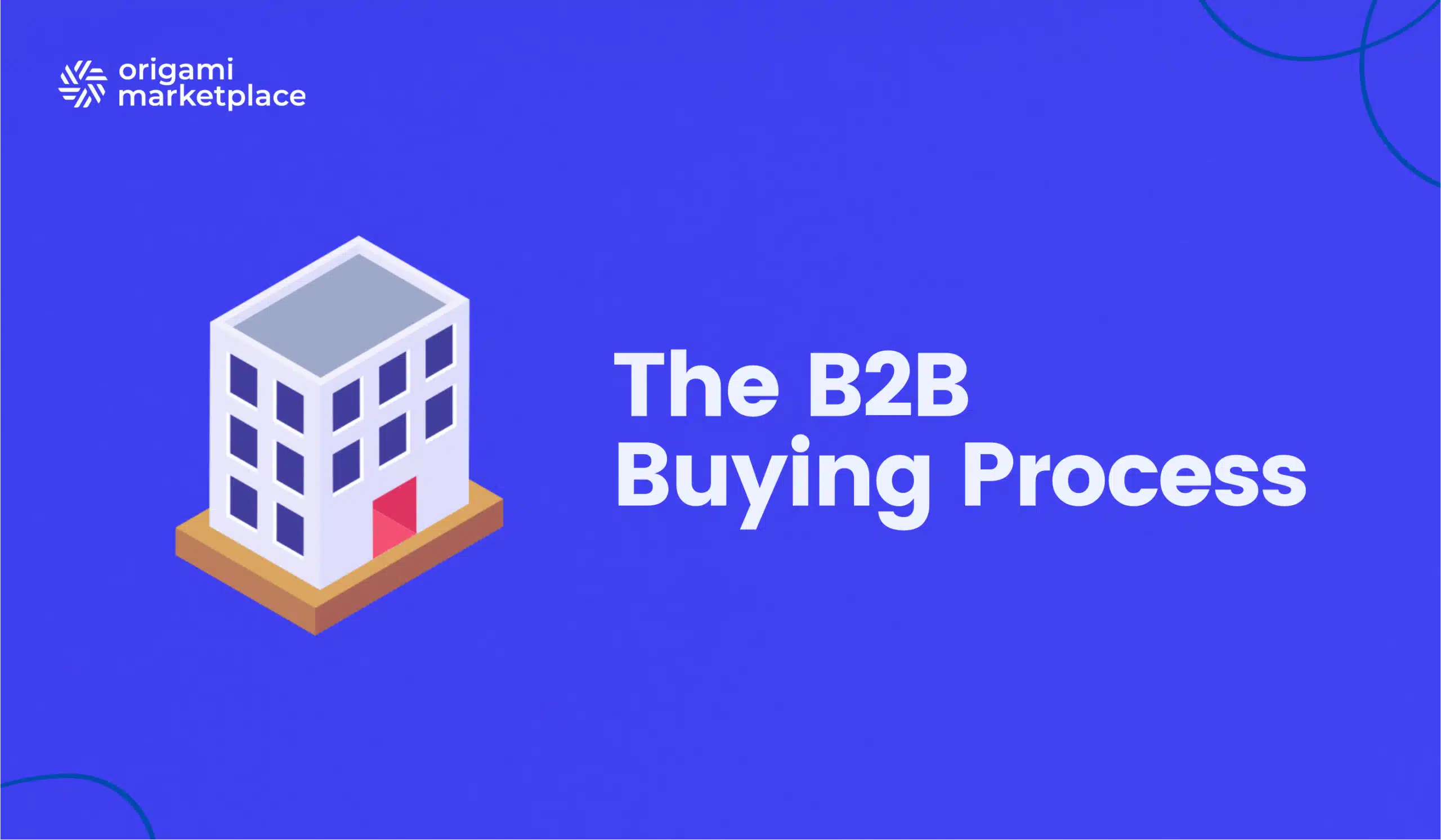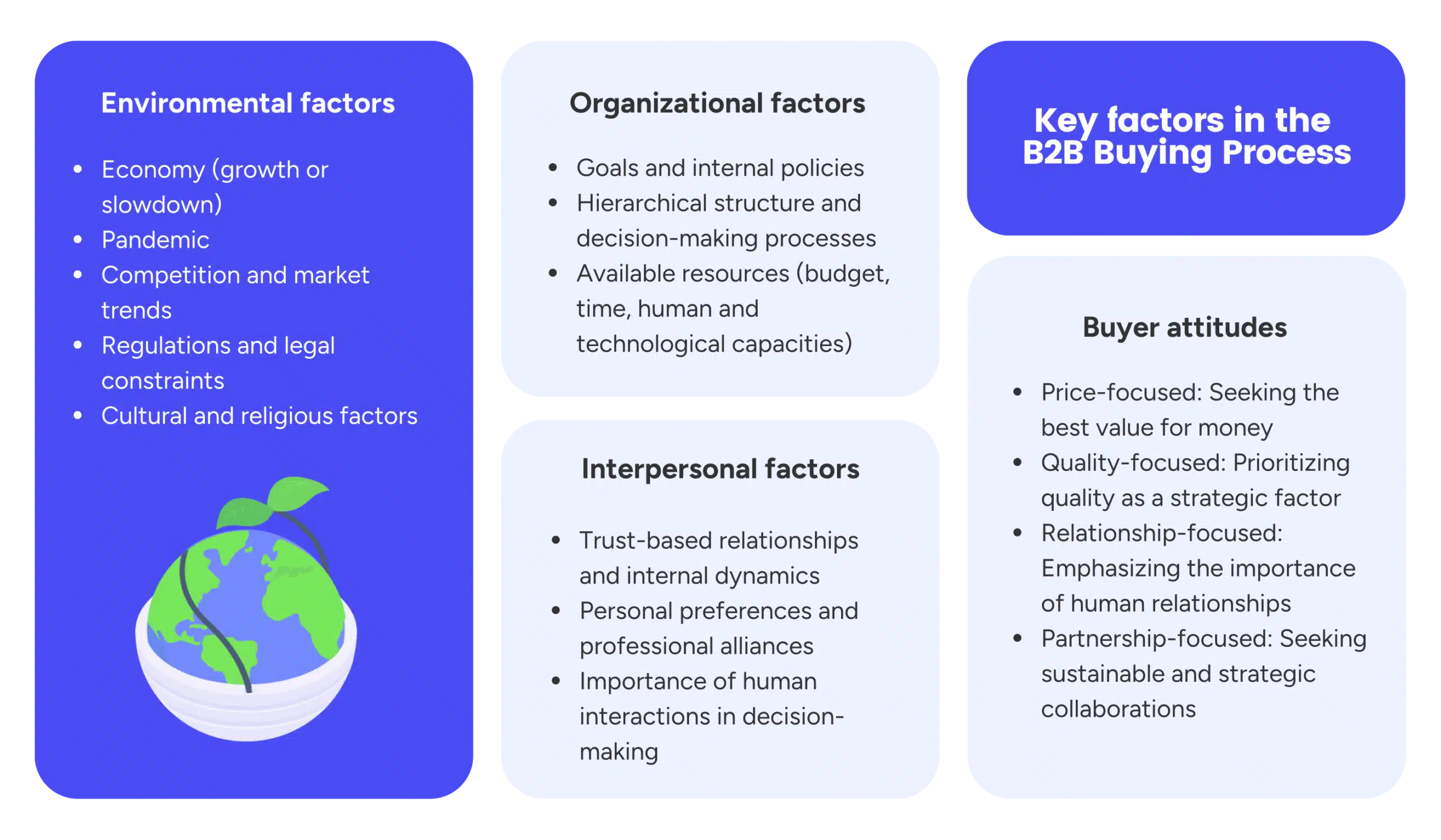The B2B Buying Process: Key stages and changes
- Arnaud
- 9 minutes reading

The B2B buying process has undergone significant changes in recent years. As market dynamics evolve, driven by new technologies and the rise of digital channels, companies must now adjust their commercial and logistical strategies. Understanding these transformations is crucial to staying competitive and optimizing the effectiveness of your sales teams.
In this article, we will explore the main stages of the B2B Buying Process and the recent changes that are reshaping the interactions between buyers and sellers. You will also discover practical strategies to map your buyers’ journeys, anticipate their needs, and improve your commercial performance.
👋 No time to read the whole article? Find the summary here.
1. What is the B2B Buying Process?
The B2B Buying Process (Business-to-Business) refers to the set of steps and processes a company goes through to acquire goods or services from another business. It is a more complex journey than that seen in B2C (Business-to-Consumer) because it involves multiple stakeholders within the purchasing organization, each having specific roles (recommenders, buyers, decision-makers, etc.).
The B2B Buying Process generally consists of seven major steps, which we will explore in the next part of this article:
- Identifying the need and defining requirements
- Researching information and exploring solutions
- Comparing solutions and selecting suppliers
- Decision-making and purchasing
- Post-purchase evaluation and strengthening relationships
- Usage and retention
- Ongoing evaluation and re-evaluation
However, not all companies follow these steps in the same order, as each purchase may vary depending on the complexity or specifics of the organization. Success in this process depends on understanding customers’ needs, providing tailored solutions, and building strong long-term relationships.
Using a marketplace-based solution, like Origami Marketplace, simplifies managing these steps with tools such as vendor integration and personalized product displays. This ensures optimal fluidity while providing precise and quick responses to buyers.
“In the B2B sector, distribution networks are often complex, involving distributors, brokers, and end clients, each with specific expectations and needs. When a company tries to bypass this network by launching a direct e-commerce channel, tensions may arise within the value chain. This is why it's crucial to understand your ecosystem's dynamics and interactions before initiating a digital transformation, to ensure a smooth transition and an optimized buying process for all stakeholders.”

Alexandre Duquenoy
→ Talk to our B2B solutions expert
2. What are the stages of the B2B Buying Process?
1. Identifying the need and defining requirements
The buyer becomes aware of a need within their company. At this stage, they start seeking information to better address this need and consider existing solutions. This stage can involve researching educational content, technical reports, case studies, as well as consulting colleagues, networks, or experts.
2. Researching information and exploring references
After identifying the need, the B2B buyer begins evaluating available options. They conduct deeper research on existing catalogs and potential suppliers. Often, they consider several criteria such as quality, price, supplier reputation, delivery times, features, complexity, and return on investment.
3. Comparing products and selecting suppliers
The buyer narrows down their options to a shortlist of suppliers. At this stage, they directly engage with suppliers, request proposals, and begin negotiations. Internal stakeholders must also be aligned with the final decision.
4. Decision-making and purchasing
After comparing proposals, conducting necessary negotiations, and securing approval from stakeholders, the buyer makes a final purchasing decision. The company then proceeds with the purchase or signs a contract.
5. Post-purchase evaluation and strengthening relationships
Once the purchase is made, the product or service is implemented within the company. This may include user training, technical installation, or integration with other existing systems. This stage is crucial to ensure that the solution works well and meets expectations.
6. Usage and retention
After the purchase and implementation, the buyer assesses the effectiveness of the product or service. If the experience is positive, the company is likely to become a loyal customer, renew its contract, or make additional purchases if the buying process is not too complex.
7. Ongoing evaluation and re-evaluation
At the end of the product’s lifecycle or upon contract expiration, the company reassesses the supplier’s and the product’s performance. This stage is important for deciding whether to continue working with the same supplier or explore other options.
Download our free B2B marketplace specifications template.
Here you will find all the essential features to succeed in your B2B multi-vendor marketplace. This model provides a simple backlog to guide you through each step of your project.
3. How has the B2B Buying Process evolved?
1. Accelerated digitalization
The B2B buying process has undergone a major digital transformation. B2B e-commerce platforms, purchasing or referencing hubs, ERP (Enterprise Resource Planning) solutions, CRM systems, and marketplaces have simplified each stage, from need recognition to final approval. Now, businesses can access online catalogs, automate quote requests, and track orders in real-time. Integrating a marketplace-based solution like Origami Marketplace pushes this digitalization even further with advanced features such as automated fulfillment and shipping. This allows centralization and easy management of all buying process stages, from order to delivery.
2. Personalization of experiences
B2B buyers now expect a personalized, seamless, and simple experience, similar to what they experience in B2C. Suppliers must now use artificial intelligence tools, recommendation engines, and data analysis to offer tailored recommendations and offers that meet the specific needs of each company.
3. Omnichannel and accessibility
LB2B buyers now use an omnichannel approach, interacting with suppliers through various channels (websites, emails, phone calls, social media). Suppliers must ensure a consistent and smooth customer experience, regardless of the channel used. This evolution reflects changes in B2C, where consumers expect to interact with a brand across multiple touchpoints.
4. Complexity and number of decision-makers
B2B purchasing decisions have become more complex, involving an average of 6 to 10 decision-makers. This lengthens the decision cycle but also ensures that the purchase aligns with the company’s strategic goals. Collaboration between these stakeholders requires greater coordination and better information management, which a B2B solution must be able to provide easily.
5. Non-linear buying process
The B2B Buying Process is no longer linear. Buyers often revisit stages to validate or reconsider their choices. This non-linearity requires greater flexibility from suppliers, who must be ready to provide information at any stage of the process.
4. What factors influence the B2B Buying Process?
The B2B Buying Process is influenced by various factors, ranging from external conditions to internal and interpersonal elements. Some of these factors can be controlled and optimized, while others, such as economic or cultural factors, require adaptation and responsiveness.

1. Environmental factors
External conditions, such as the economy, geopolitical conflicts, competition, and market trends, directly influence the B2B Buying Process. During periods of economic growth, businesses invest more, while during slowdowns, they reduce or postpone purchases. Regulations and legal constraints also limit buyers’ options, especially in heavily regulated industries. Finally, cultural and religious factors can affect the timing of purchasing decisions.t.
2. Organizational factors
A company’s goals, internal policies, and decision-making processes heavily influence its buying process. The hierarchical structure and strategic priorities determine supplier choices and how decisions are made. Available resources, such as budget, time, and human or technological capabilities, also affect supplier selection and the duration of the buying process, which can vary depending on consultations, approvals, and negotiations needed.
3. Interpersonal factors
In the B2B Buying Process, interpersonal relationships play a crucial role. Unlike B2C, where the buying decision is often individual, in B2B, multiple people participate in the decision. For example, a decision-maker may favor a supplier due to an existing trusted relationship. Internal dynamics, such as personal preferences or professional alliances, can also subtly influence the buying process. Sales teams need to understand these interactions to optimize their influence at key moments in the process.
4. Buyer attitudes
B2B buyers, although acting in a professional context, have specific priorities and attitudes that influence the buying process. Unlike B2C, where decisions are often more emotional, B2B decisions are primarily guided by tangible and pragmatic criteria:
- Price-focused: They prioritize the best value for money and seek economical solutions.
- Quality-focused: These buyers place the quality of the product or service at the heart of their decision, seeing it as a strategic factor.
- Durability-focused: B2B buyers seek products that will last, allowing them to amortize the investment.
- Relationship-focused: For them, human interactions and the quality of the supplier-client relationship are essential before, during, and after the purchase.
- Partnership-focused: They aim to establish long-term relationships with suppliers, focusing on strategic and sustainable collaborations.
By understanding these different profiles, suppliers can tailor their approach to match each buyer’s specific priorities and more effectively influence the buying process.
5. Who are the stakeholders in the B2B Buying Process?
In the context of the B2B Buying Process, several actors, both internal and external to the company, intervene at different stages and influence the final decision. Each stakeholder plays a specific role essential to the success of the process. Here are the main roles involved:
- Initiator: The person who identifies a need or improvement opportunity and communicates it to the responsible parties. This can be anyone within the organization.
- Buyer: Responsible for managing the acquisition of the product, service, or solution. This may be a purchasing manager or department head who validates the transaction.
- Decision-maker: The one with final authority to approve the purchase, often a senior executive, business development manager, or financial officer.
- Influencers: Experts, either internal or external, whose recommendations can shape the decision. This includes consultants, department heads, or members of a purchasing committee.
- Gatekeepers: Those who control access to information within the company. These can be administrative assistants, document managers, or other collaborators who filter communications.
- User: The person who will use the product or service once acquired. Their feedback is often crucial to validate the product choice based on operational needs.
Each of these actors plays a decisive role in ensuring that the purchasing decision meets the company’s requirements while optimizing the decision-making process.
“Implementing a new B2B buying process requires involving sales teams from the start. Digital tools should be seen as enablers that allow salespeople to focus on higher-value tasks, such as prospecting or upselling. Meanwhile, repeat and lower-priority orders can be effectively handled via a B2B marketplace, thus optimizing the overall process efficiency.”

Antoine Mantel
→ Talk to our B2B solutions expert.
6. Comment optimiser le parcours d'achat B2B ?
- Map the buyer’s journey: Mapping the B2B buyer’s journey allows businesses to visualize every customer interaction, identify friction points, and improve the overall experience. This approach helps understand where buyers encounter obstacles and find solutions to streamline the process.
- Accommodate buyer needs: Each B2B buyer is unique. Companies often have multiple divisions, teams, or departments, each with specific needs. It is essential to tailor your offering to meet these various requirements to better serve each subgroup and maximize customer satisfaction.
- Facilitate product comparisons: Faced with an abundance of options, B2B buyers can be overwhelmed. Offering a comparison feature, whether between different products or competing solutions, allows customers to make more informed decisions. You can also simplify their choice by comparing different versions of your own products.
- Inform and educate customers: Professional buyers need reliable information to make objective decisions. Providing detailed content, such as guides or case studies, helps them better understand their options and choose the best solution for their needs.
- Support customers throughout the process: Sales teams should act as guides to assist buyers throughout their online buying journey. This can include help navigating your e-commerce platform, submitting documents, or obtaining additional information, such as prices or certifications.
- Recommend products at the right time: An effective approach to boosting sales and satisfaction is recommending suitable products or services at the right moment. In addition to recommendations, sharing reviews from existing clients can strengthen your offers’ credibility and make decision-making easier.
- Offer personalized and relevant pricing: Offering personalized prices tailored to each client’s specific needs reduces uncertainties during the purchase. Using automated pricing engines can also ensure that the displayed price is always fair and aligned with the customer’s expectations.
- Understand customers’ approval processes: B2B purchases often involve multiple decision-makers and a complex approval process. By understanding buyers’ approval stages, you can better assist them in progressing through their purchase and facilitate validation at each phase.
- Simplify document management: B2B companies often handle a large volume of documents throughout the purchasing process (quotes, contracts, invoices). Providing tools to submit and approve these documents online simplifies administrative management and reduces paperwork.
- Optimize validation, payment, and delivery: Each company has its own requirements regarding the validation, payment, and delivery process. It’s important to understand these specific needs, whether simple or complex, and address them adequately to offer an experience as smooth and personalized as what you find on Amazon.com, for example.
- Use the right technical solution to improve the buying process: Leveraging appropriate technological solutions helps simplify and speed up the B2B Buying Process. Platforms like Origami Marketplace offer advanced features such as workflow automation for quote requests, dynamic pricing, and tailored B2B account management. These tools allow you to adapt the process to your clients’ specific needs and accelerate the sales cycle.
“The automation of B2B purchasing processes, especially through the implementation of a dedicated marketplace, significantly reduces errors and improves operational efficiency. This transformation results in notable productivity gains, increased customer satisfaction, and reduced administrative costs, strengthening the company’s overall competitiveness.”

Alexandre Duquenoy
→ Talk to our B2B solutions expert.
The B2B Buying Process has significantly evolved with the rise of digitized B2B platforms and increasing buyer expectations. To stay competitive, it is essential to understand these changes and adapt to them.
A marketplace-based solution like Origami Marketplace centralizes and automates the various stages of the buying process, offering a flexible and scalable solution. By integrating features such as volume-based pricing, workflow management, and customized payment options, it allows companies to boost productivity, optimize costs, and improve buyer satisfaction.
By adopting a strategic approach and remaining flexible in the face of evolving buying processes, you’ll be better prepared to meet the complex and changing needs of your B2B clients.
In summary: Why is a multi-vendor solution ideal for the B2B Buying Process?
Key points to remember:
- Increasing complexity of the B2B Buying Process: The process is longer and involves multiple decision-makers. Digitalization simplifies and speeds up these stages.
- Inevitable digitalization: B2B companies must adopt digital platforms to remain competitive and offer a seamless customer experience.
- Personalization: B2B buyers expect tailored offers that meet their specific needs, similar to B2C experiences.
- Omnichannel: Buyers use multiple channels (web, email, phone), so it’s essential to offer a consistent experience across all of them.
Why a multi-vendor solution is the perfect choice:
- Centralization: A marketplace like Origami Marketplace brings different suppliers together in one place, simplifying research, comparison, and purchasing.
- Automation: The purchasing process is streamlined thanks to workflow automation, reducing errors and increasing efficiency.
- Personalization and dynamic pricing: It offers tailored recommendations and prices that meet each buyer’s needs, enhancing customer satisfaction.
- Ease of managing key steps: From quote requests to delivery, everything is optimized, ensuring a frictionless process.
Discover how Origami Marketplace’s API and partner network can transform your business, regardless of its size, with its innovative marketplace-based solution.



